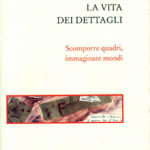
“La vita dei dettagli”
testo di Antonella Anedda
“Arles di Cesare Di Liborio” ![]()
Di soglia in soglia.
Il portale mette in relazione il visibile con l’invisibile. Arles, Saint Gilles come Burgos erano Colonne d’Ercole che la cristianità poteva oltrepassare.
Ricordo Le Colonne d’Ercole di Cesare Di Liborio, pilastri a volte con, altre senza cancelli, ricordo una foto con tre porte cieche, su di una lunga banchina di cespuglio. È quanto di più simile alla Trinità io abbia visto. Le finestre apparivano come nell’iconografia popolare di Fatima o di Lourdes. Una forma sacra si depone su di uno spazio usuale, sulle piante, sui rami e sui rovi che sono anche il nostro quotidiano. La grazia è l’improvvisa visione su alberi, porte, nebbia e ghiaia. Cesare Di Liborio:” I portali sono soglie verso l’ignoto, le porte chiuse sono barriere mentali al di là delle quali non vediamo e non conosciamo”.
In Provenza dove ha esposto nel 2000 (Museo Réattu) e nel 2003 (Fondazione Maeght) Di Liborio ha fotografato, per la Municipalità di Arles i ferrovieri presso l’Atelier SNCF, l’edificio dove si restauravano le carrozze dei treni. Guardali, affiorano da altro, da uno spazio che li spinge verso di noi a sorpresa, uno spazio che li contiene ma anche li espelle. Uno sfondo buio, come quello che ci lasciamo alle spalle nascendo. Diversamente dai lavoratori fotografati nel 1929 da August Sander, i ferrovieri di Di Liborio non si “adattano” al loro strumento di lavoro, non “fissano” lo spettatore al centro dell’immagine. Al contrario chiedono a chi guarda di accoglierli nel proprio spazio, di trasformarli in proprie presenze. Anche qui come nei cancelli o nelle colonne circondate dal vuoto, la fotografia è una porta che accoglie e separa nel brivido che da sempre scorre sulla cresta dello sguardo.
Le parole di Jacques Le Goff, nel testo di accompagnamento alla mostra di Di Liborio, Le colonne d’Ercole, rintoccano sui versetti del Vangelo di Giovanni. “La prospettiva spirituale, metafisica”, scrive Le Goff dopo aver citato il versetto, “è principalmente naturale, geografica”. Lo spazio si schiude, si trasforma e trasforma. Il portale di Saint-Trophime, l’acanto dei capitelli, i santi stilofori si ritrasformano in alberi e piante, la sua polvere vola fino in Italia, anzi in Emilia dove Di Liborio ha fotografato i suoi cancelli.
Non è forse la stessa polvere che Benedetto Antelami portò dalla Provenza al Battistero di Parma?
Antonella Anedda
“Arles by Cesare Di Liborio” 
From threshold to threshold
The portal put the visible and the invisible in communication. Arles, Saint Gilles like Burgos were Pillar of Hercules that Christianity could go beyond.
I remember The Pillar of Hercules by Cesare Di Liborio, columns at time with, or without gates, I remember photos with three blind doors, on a long hedge. It’s the closest I’ve ever got to seeing the Trinity. The windows appeared like in the popular iconography of Fatima or Lourdes. A sacred form lands in a usualspace, on plants, on branches and on the brambles that are also a part of our daily existence. The Grace is the sudden materialisation on trees, doors, fog and gravel. Cesare Di Liborio: “The portals are gates onto the unknow, the closed doors are mental barriers beyond which we can’t see and can’t know”.
In Provence where he exhibited in 2000 (Réattu Museum) and in 2003 (Maeght Foundation) Di Liborio has photographed, on behalf of the Arles Council, the railway workers at the SNCF Atelier, the building where the train carriages are repaired. Look at them, they seem to surface from elsewhere, out of a space that pushes them towards us surprisingly, a space that contains them but also expels them. A dark background, like the one we leave behind at birth. Unlike the workers photographed in 1929 by August Sander, Di Liborio’s railmen do not “adapt” to their work tool, they don’t “stare” at the spectator in the middle of the image. On the contrary they ask the onlooker to invite them into the space, to transform them into presences of theyr own. Here again, as with the gates and columns surrounded by emptiness, photography is a door that welcomes and separates in the thrill that has always coursed along the crest out fo the gaze.
I remember the words of Jacques Le Goff, in the notes to Di Liborio’s exhibition, The Pillars of Hercules, in which sound the verse of St. John’s Gospel. “The spiritual, metaphysical perspective” Le Goff writes after having quoted the verses, “…is primarily natural, geographic”. The space opens out, is transformed and transforms. The Saint-Trophime portal, the acanthus of the capitols, the columnbearing saints are retransformed into trees and plants, the dust flies all the way to Italy, in fact to Emilia where Di Liborio has photographed his gates. Isn’t it the same dust that Benedetto Antelami brought from Provence to the Baptistery in Parma?
Antonella Anedda